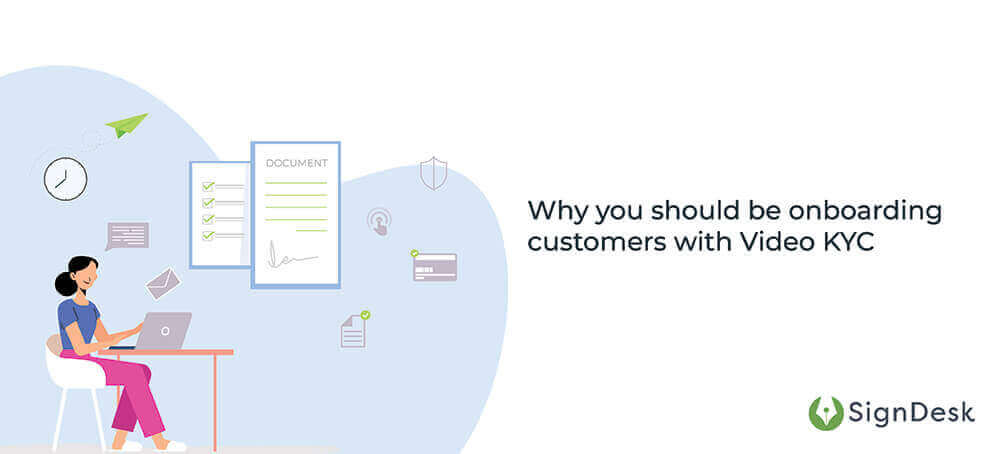Video KYC
The Reserve Bank of India (RBI) recently issued a notification dated January 9th, 2020, legitimizing the Video-Based Customer Identification Process (VCIP) as a valid method for collecting the KYC information of customers and subsequently onboarding them
This notification is forecasted to have a wide range of beneficial effects on the various financial institutions in India. Here we will classify and examine these benefits and tell you why you should be using the Video KYC Process to onboard your customers.

What does VCIP involve?
According to the RBI’s notification, VCIP consists of several steps involving, among other things, an audio-visual interaction, geo-tagging, and facial matching.
The steps have been formulated to make the collection of KYC information an entirely digital process.
This complete digitization is partially responsible for many of the advantages of Video KYC, as we shall soon see
Benefits of Video KYC
For the sake of convenience and neatness, the benefits of Video KYC have been divided into two broad categories – Benefits for Customers and Benefits for Businesses.
Benefits for Customers
Customers will experience numerous benefits due to Video KYC, some of which have been outlined below :
- Customer convenience. Customers will not have to leave the comfort of their homes to get their KYC information authenticated. As the Video KYC Process is completely digitized, the authentication can be done remotely.
- Fast and automated data capture. RBI encourages the use of facial matching software and AI techniques to capture data from video in VCIP. This will allow more data to be captured quickly from minimal input and will be vastly beneficial to customers in terms of convenience and innovation.
- A rising tide lifts all boats. The usage of the aforementioned AI and ML techniques for Video KYC will encourage interest and novelty in these areas. This will be advantageous to the nation in the long-run.
As we have seen, the benefits reaped by customers due to Video KYC mostly involve convenience and long-term gains. Now let’s explore what businesses and financial institutions stand to gain from adopting the Video KYC Process.
Benefits for Businesses
The Video KYC Process, which follows the recommendations of the expert committee on Micro, Small, and Medium Enterprises (MSME), is designed to benefit businesses.
It does so in the following ways :
- The process is incredibly cost-effective. This is quite obvious given that the process is digitized and remote, but It’s worth going into some detail to examine the ways in which businesses can cut costs by adopting Video KYC :
- Aadhaar licenses, which financial institutions require to authenticate customers using their Aadhaar cards are no longer needed as Video KYC is digitized.
- Companies can cut costs on the hardware required for verification, as Video KYC only requires a device with a camera and internet access.
- Officials will not be required to travel to various locations in order to perform customer verification, so companies can save on travel costs.
- The turnaround time (TAT) for customer onboarding is greatly reduced as the Video KYC process is expedited. This will also cut costs for companies by more than 90%.
- Innovation is encouraged. The steps of Video KYC stipulated by the RBI leave a lot of room for innovation and improvement. Additionally, the fully digitized nature of the process encourages the use of emerging technology to strengthen the process and integrate it with other methods. It’s worth looking at how this can be done:
1- Machine Learning. ML could be said to be the defining technology of our age. Its techniques can be used in VIPV and VCIP to lower false positives. The screening of false positives could potentially lengthen the Video KYC process, leading to customer dissatisfaction, and ML can be used to deal with this effectively.
Additionally, ML techniques can be used to automate the Video KYC Process through automatic face and document detection. SignDesk’s Digital KYC application, Scan.it, uses AI and ML techniques to perform real-time face and document detection
Scan.it also uses ML methods to lower false positives in the process through its fraudulent profile filter.
2-Artificial Intelligence. Methods involving AI and robotics have massive potential to automate the data-gathering process and completely streamline the steps involved in Video KYC.
Scan.it makes use of AI techniques to make the KYC onboarding process smooth, automated, and secure.
Customer KYC onboarding with SignDesk
SignDesk is primarily focused on creating a smooth and seamless workflow for businesses, including digital student onboarding. KYC onboarding is an integral part of the workflow of any business, and since Video KYC deals with precisely this, our Digital Video KYC solution is geared towards making the KYC onboarding process as smooth, integrated, and automated as possible.
Our product, Scan.it, uses AI and ML methods so that both businesses and customers can reap all the benefits of Video KYC mentioned above.
Try out our product today and experience the future of customer onboarding.